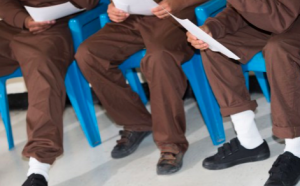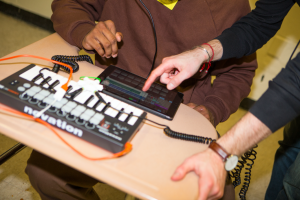The Justice-in-Education Initiative is a collaboration between the Center for Justice at Columbia University and the Heyman Center for the Humanities, along with the Media and Idea Lab of the Center for the Study of Ethnicity and Race, to provide educational opportunities to incarcerated and formerly incarcerated persons and to integrate further the study of justice into the Columbia University curriculum.
Although, the United States comprises only five percent of the world’s population, we have more than twenty-five percent of the world’s prisoners. Columbia University sits at the heart of our current mass incarceration crisis. According to the Justice Atlas of Sentencing and Corrections, more than 50% of all incarcerated Manhattanites call Harlem home. Yet statistical evidence overwhelmingly confirms that a college education reduces recidivism, increases employment opportunities, and strengthens communities. The Justice-in-Education Initiative seeks to provide greater educational opportunities to those who are or have been incarcerated, as well as to enrich the academic life of faculty and students wishing to engage in issues of contemporary justice.
The Justice-in-Education Initiative aims to do the following:
Aim 1 is to offer courses, taught by Columbia instructors, in local prisons and to provide those who have come home from prison with the opportunity to continue their education at Columbia and its partner institutions, drawing on the support of community organizations.
The Justice-in-Education Initiative offers courses, taught by Columbia instructors, in local prisons and provides those who have come home from prison with the opportunity to continue their education at Columbia and its partner institutions. For formerly incarcerated persons and court-involved youth, Justice-in-Education provides a skills-intensive humanities course offered through Columbia’s Department of English and Comparative Literature and conducted on Columbia’s Morningside Campus.
Aim 2 is to provide opportunities for jailed youth to engage with education.
In Rikers Island jail, where the average stay is around three months, Columbia faculty and students are offering college-oriented educational programming to youth and young adults ages 16 to 24 years. These programs – that take the form of mini-courses on topics including hip hop/beat making, computer coding, and developing a business plan – are designed to engage young people who are incarcerated.
Aim 3 is to develop strong curricular support for the effective engagement of Columbia faculty and students in prison and jail education.
The Justice-in-Education Initiative provides Columbia students and faculty with an interdisciplinary framework for understanding criminal justice issues by supporting the development of new course offerings within the undergraduate curriculum that engage contemporary issues of justice. It also supports the development of a new website, designed in conjunction with Core preceptors and students, that would support discussion of contemporary justice issues.
Aim 4 is to change public and political thinking about the importance of access to higher education for the incarcerated and the formerly incarcerated.
In collaboration with the Media and Idea Lab at the Center for the Study of Ethnicity and Race, the Justice-in-Education Initiative will address how to change the narrative about incarcerated people so as to emphasize their potential to grow and develop. Columbia faculty and students will work with community partners to produce new narratives about incarceration. These stories will emphasize the role of education in human development, whether behind bars or in the successful reentry of those coming home from prison.
 The Justice-in-Education Initiative strives to not only make higher education available to a population that has been effectively excluded from it, but also contributes to the growing movement to end mass incarceration.
The Justice-in-Education Initiative strives to not only make higher education available to a population that has been effectively excluded from it, but also contributes to the growing movement to end mass incarceration.
CLICK HERE TO VISIT OFFICIAL WEBSITE
The Justice-in-Education Initiative is supported by a grant from the Andrew W. Mellon Foundation.


